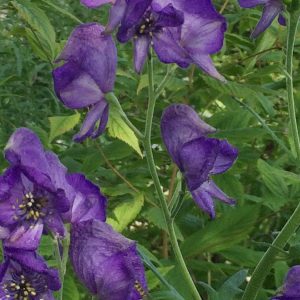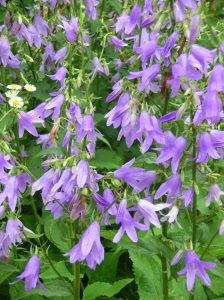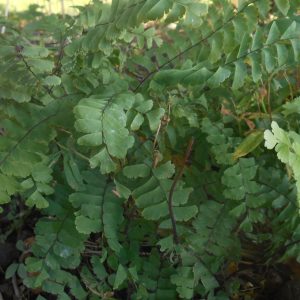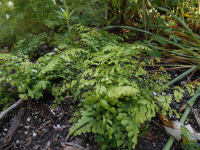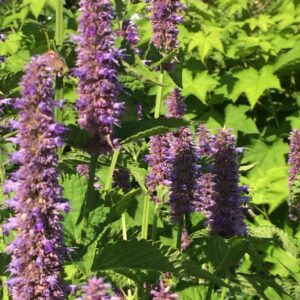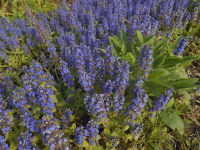Our Plants
Showing 9–16 of 587 results
-
Aconitum napellus Monkshood Wolfsbane Z 5-8 POISON
Striking, late summer to fall tall stalks, top third covered with flowers, blue washed purple each topped with a hood, in ancient times like a monks’ hood, today like a sweatshirt’s hoody.
Striking, late summer to fall on the top third of tall stalks, covered with flowers, blue washed purple each topped with a hood, in ancient times like a monks’ hood, today like a sweatshirt’s hoody.
LIMITED QUANTITIES AVAILABLE, LIMIT OF 1 PER CUSTOMER PLEASE.
Size: 2-3’x 12”
Care: part shade, cool, moist soil
Native: Europe
Wildlife Value: Aconitums are unusual. They change sex, which, in turn increases procreation! When first blooming they have a “male phase” of about 5-6 days when pollen is available, and the plant produces more nectar and stronger scent. Then the male parts wither making the pollen available to the female parts. The pollen is toxic to bees so most avoid it leaving more for the female parts, therefore increasing fertilization. However, bees are able to collect nectar without harm. https://botany.one/2019/11/aconitum-offers-bees-more-nectar-to-carry-its-toxic-pollen/ Also deer resistant.
Awards: Elisabeth Carey Miller Botanical Garden Great Plant PicksThe name Aconitum is from the mythical hill Aconitus in Pontica where Hercules fought with Cerberus. The Monkshood reputedly sprang from the jaws of Cerberus, the guard dog of the underworld. Believed to make a potion that helped witches fly. Identified by Dioscorides in De Materica Medica for medicinal use c. 70 A.D. Philip Miller in The Gardener’s Dictionary (1768) wrote that the name Aconitum comes from Greek word for dart “because the Barbarians used to daub their darts therewith.” Used by physicians in 1200’s and to poison wolves: “This Wolf’s bayne of all poisons is the most hastie poison.” Wm. Turner, 1560’s. Called Monkshood due to the shape of each flower like a monk’s hood. Introduced to the new world by John Winthrop in 1631.
-
Actaea pachypoda syn. Actaea alba White baneberry Z 3-8
Short white spike flowers in June, conspicuous white berries in fall with a black dot on showy crimson stems.
OUT OF STOCK
Short white spike flowers in June, conspicuous white berries in fall with a black dot on showy crimson stems.
Size: 36”x 18-24”
Care: part to full shade in moist well-drained soil
Native: native to eastern and central No. America; Wisconsin native.
Wildlife Value: deer resistant
Awards: England’s Royal Horticultural Society Award of Merit and Great Plant Pick Award from Elizabeth Carey Miller Botanical Garden.Actaea is Latin meaning “elder,” the leaves resembling the elder tree. Pachypoda means thick foot referring to the stalk. The common name “baneberry” chosen because the berries are poisonous. The Blackfoot boiled the roots to cure coughs and colds. In the 1800’s, used to cure “reflex uterine headache, rheumatism, congestion in the female especially, debility and gastralgia.” Sent to England before 1768, Philip Miller.
-
Adenophora lilifolia Ladybells Z 3-8
Fragrant, flared, drooping bluebells in midsummer, July and August
Fragrant, flared, drooping bluebells in midsummer, July and August
Size: 18" x 12" spreading
Care: full sun to part shade in moist, well-drained soil
Native: central Europe east to SiberiaAdenophora is Greek from aden meaning “gland” and phore meaning “to bear.” Named and renamed many times from 1753. “Fragrant blue flowers, freely borne on a loose pyramidal inflorescence.” H.H. Thomas, 1915. “Well suited for the mixed border.” William Robinson, 1899.
-
Adiantum pedatum Maidenhair fern Z 4-9
Grown for its delicate-appearing leaflets arranged in rows. One of internationally known garden designer Piet Oudolf’s 100 “MUST HAVE” plants, Gardens Illustrated 94 (2013)
Grown for its delicate-appearing leaflets arranged in rows. One of internationally known garden designer Piet Oudolf’s 100 “MUST HAVE” plants, Gardens Illustrated 94 (2013)
Size: 12-24”x 12”
Care: Shade in moist to moist, well-drained soil
Native: all parts of No. America including Wisconsin
Awards: England’s Royal Horticultural Society Award of Merit.Cherokee made a tea from this for flu, fever, and rheumatism, paralysis and asthma. Native Americans used stem to make a hair wash and applied a topical poultice of masticated fronds to wounds to stop bleeding. 1st described by French botanist Cornut in 1635. Introduced to gardens in 1635 from Canada where it grew in “such quantities that the French sent it from thence in package for other goods and the apothecaries at Paris use it for (another Maidenhair) in all their compositions in which that is ordered.” Philip Miller (1768). Englishman Tradescant the Younger introduced it to English gardens in 1638 when he sent it from Virginia Colony to London. English herbalist Nicholas Culpepper claimed it as “a good remedy for coughs, asthmas, pleurisy, etc., and on account of being a gentle diauretic, also in jaundice, gravel and other impurities of the kidneys.” (1652). Father of mixed perennial gardens, William Robinson, called this “elegant…unquestionably one of the most distinct and beautiful of the hardy ferns.” The Garden 1876.
-
Adiantum venustum Himalayan maidenhair fern Z 5-8
Black stems hold triangular, delicate, lacy fronds of tiny leaflets
OUT OF STOCK
Black stems hold triangular, delicate, lacy fronds of tiny leaflets. Favorite short fern.
Size: 6" x 12", slow spreader
Care: part or light shade in moist well-drained soil but tolerates any soil
Native: China and Himalayan Mountains
Awards: Great Plant Pick from Elisabeth Cary Miller Botanic Garden & Royal Horticultural Society Award of Garden MeritAdiantum is from Greek adiantos, “unwettable” because its fronds repel water. Venustum means attractive in Latin. (We think it should be “venustumest” for most attractive.) Collected for gardens by 1841.
-
Adlumia fungosa Allegheny vine, Climbing fumitory, Bleeding heart vine Biennial Z 4-8
Dangling pink to white Bleeding heart-like flowers bloom all summer, June-September. Fern-like foliage on twining stems
OUT OF STOCK
Dangling pink to white Bleeding heart-like flowers bloom all summer, June-September. Fern-like foliage on twining stems
Size: 6-10’ x 12”
Care: part shade to shade in moist to moist well-drained, acidic soil
Native: Nova Scotia to No. Carolina west to Minnesota Wisconsin native status-special concern
Wildlife Value: attracts bumblebees1st described in 1789 (Aiton, Vol. 3 Hortus Kewensis).
-
Agastache foeniculum Anise hyssop Z 4-8
Purplish-blue spikes from July to October, very fragrant.
Purplish-blue spikes from July to October, very fragrant.
Size: 2-3' x 12"
Care: Full sun in well-drained soil, heat and drought tolerant.
Native: North America
Wildlife Value: Skipper butterflies and Rusty patched Bumble Bees love Anise hyssop’s nectar, Deer resistant.The name Agastache is from Greek agan and stachys meaning much like an ear of wheat referring to the shape of the flower spike. Anise hyssop leaves were used by American Americans of the Missouri River region to make tea and as a sweetener in cooking. For Cheyenne it relieved chest pain due to coughing or to a dispirited heart. Listed as an aromatic herb in Bernard McMahon’s 1805 book, American Gardener’s Calendar.
-
Ajuga genevensis Geneva Bugle Z 4-9
True blue 6” spikes in spring and early summer
True blue 6” spikes in spring and early summer. Great groundcover.
Size: 6” x 12”
Care: full sun to shade in well-drained to moist well-drained soil
Native: Europe
Wildlife Value: Tolerates foot traffic. Deer and rabbit resistant.William Robinson, father of the mixed perennial garden, called this “among the best.” (1933). In gardens before 1753.

